Brave New World: Globalization's Impact on Global South Countries
VerifiedAdded on 2023/06/07
|12
|2877
|187
Essay
AI Summary
This essay analyzes the multifaceted effects of globalization on the Global South, focusing on economic, social, and cultural impacts. It explores key concepts such as disembedding, mixing, and standardization, and applies sociological theories including Capitalist World System Theory, Functionalism, Conflict Theory, and Economic Power theory to understand the complex dynamics. The study examines the increase in the economic gap, the exploitation of labor, and the emergence of cultural and social conflicts. It also discusses the power of corporations, foreign aid, and social upheavals in the context of globalization. The essay argues that while globalization aims to foster development, the Global South often experiences exploitation and inequality, with corporations capitalizing on cheap resources and labor. The paper concludes that globalization's effects are complex and require a nuanced understanding of its social, economic, and cultural impacts. The essay also refers to the Jimmy Carter quote to support the argument and provides examples of the effects of globalization on the Global South and its people. The essay also draws upon the assessment criteria to support the analysis.
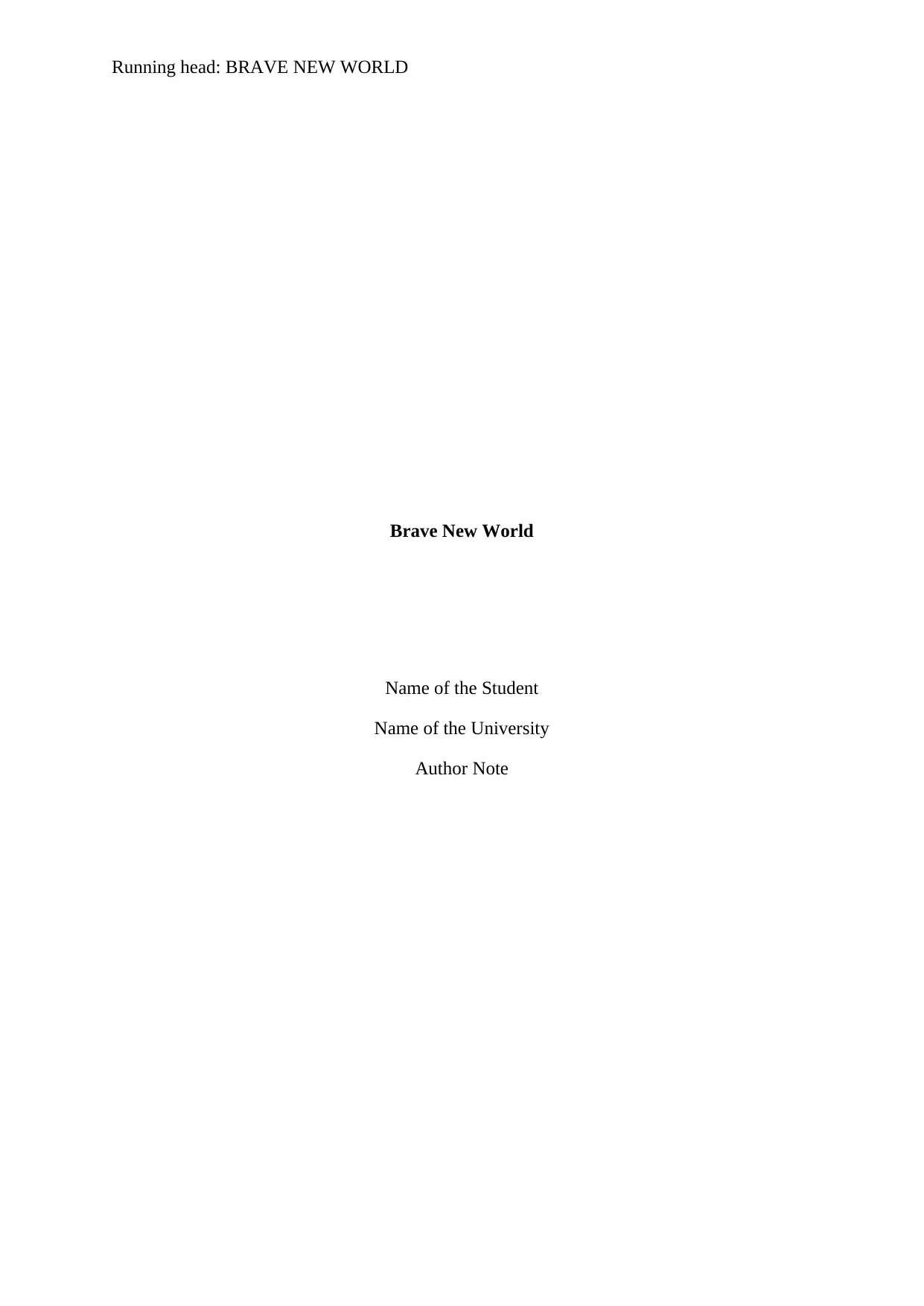
Running head: BRAVE NEW WORLD
Brave New World
Name of the Student
Name of the University
Author Note
Brave New World
Name of the Student
Name of the University
Author Note
Paraphrase This Document
Need a fresh take? Get an instant paraphrase of this document with our AI Paraphraser
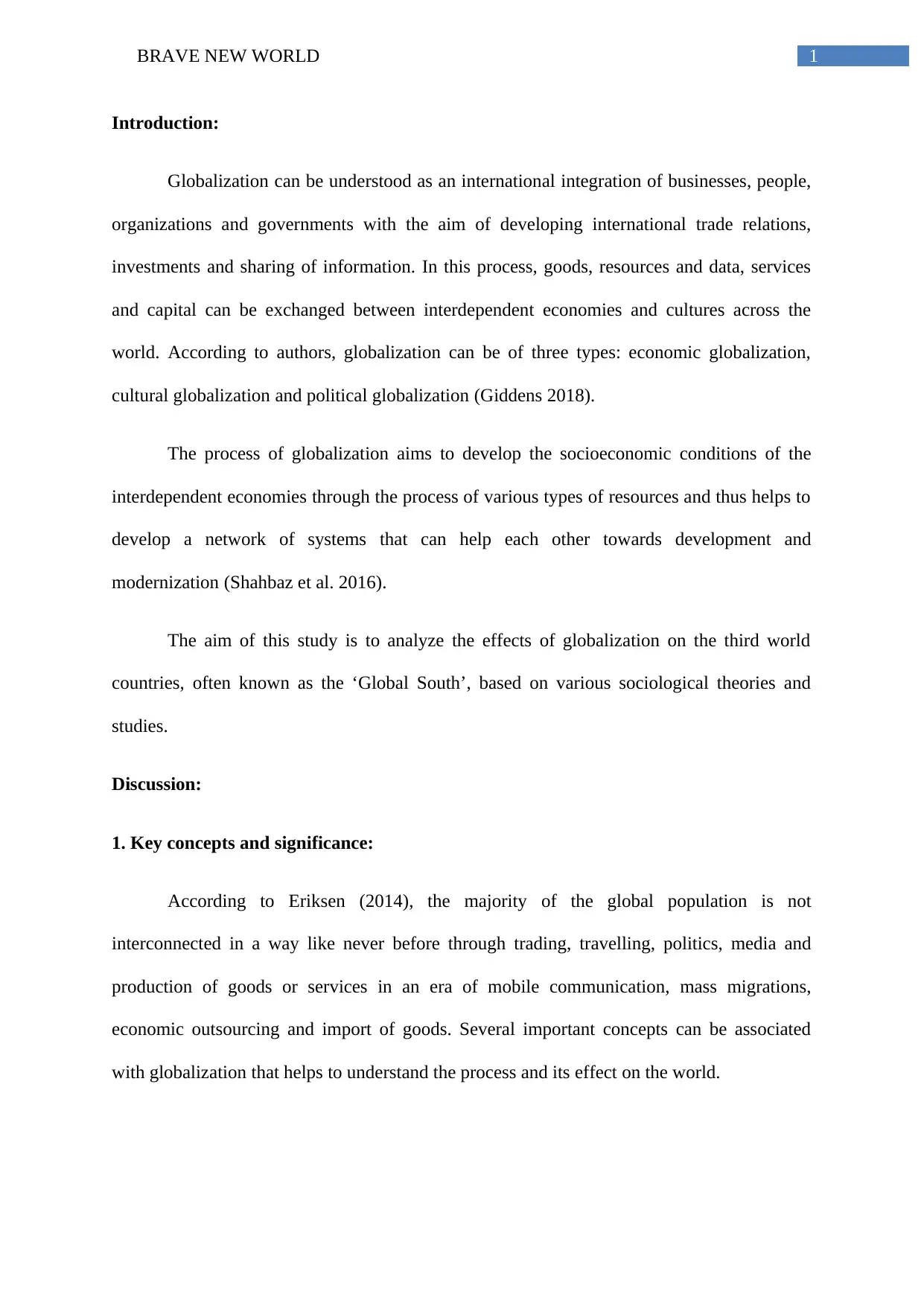
1BRAVE NEW WORLD
Introduction:
Globalization can be understood as an international integration of businesses, people,
organizations and governments with the aim of developing international trade relations,
investments and sharing of information. In this process, goods, resources and data, services
and capital can be exchanged between interdependent economies and cultures across the
world. According to authors, globalization can be of three types: economic globalization,
cultural globalization and political globalization (Giddens 2018).
The process of globalization aims to develop the socioeconomic conditions of the
interdependent economies through the process of various types of resources and thus helps to
develop a network of systems that can help each other towards development and
modernization (Shahbaz et al. 2016).
The aim of this study is to analyze the effects of globalization on the third world
countries, often known as the ‘Global South’, based on various sociological theories and
studies.
Discussion:
1. Key concepts and significance:
According to Eriksen (2014), the majority of the global population is not
interconnected in a way like never before through trading, travelling, politics, media and
production of goods or services in an era of mobile communication, mass migrations,
economic outsourcing and import of goods. Several important concepts can be associated
with globalization that helps to understand the process and its effect on the world.
Introduction:
Globalization can be understood as an international integration of businesses, people,
organizations and governments with the aim of developing international trade relations,
investments and sharing of information. In this process, goods, resources and data, services
and capital can be exchanged between interdependent economies and cultures across the
world. According to authors, globalization can be of three types: economic globalization,
cultural globalization and political globalization (Giddens 2018).
The process of globalization aims to develop the socioeconomic conditions of the
interdependent economies through the process of various types of resources and thus helps to
develop a network of systems that can help each other towards development and
modernization (Shahbaz et al. 2016).
The aim of this study is to analyze the effects of globalization on the third world
countries, often known as the ‘Global South’, based on various sociological theories and
studies.
Discussion:
1. Key concepts and significance:
According to Eriksen (2014), the majority of the global population is not
interconnected in a way like never before through trading, travelling, politics, media and
production of goods or services in an era of mobile communication, mass migrations,
economic outsourcing and import of goods. Several important concepts can be associated
with globalization that helps to understand the process and its effect on the world.

2BRAVE NEW WORLD
Disembedding:
This concept represents the movement of social, economic, political and cultural
constructs from a tangible, concrete and local context into a virtual or abstract state which
helps in the collaboration of these constructs across multiple nations and societies. This
process of abstraction and virtualization is known as disembedding (Marsden 2015). For
example, the concept of money is disembedded value; writing is disembedded language while
time on clock is disembedded time. Disembedding and virtualization can allow a resource to
be accessed from anywhere, by removing it from its physical context and its tangibility and
incorporating it in a virtual or disembedded context (Zotzmann 2016; Ferrara 2015)
Mixing:
This concept refers to the mixing and amalgamation of societies and cultures due to
the process of globalization. The interconnectedness of the culture due to better
communication and flow of information results in the formation of a mixed culture in
different countries. For example, the concept of westernization of developing countries imply
the flow and adoption of western values and ideologies into non western societies, which
reflects in their social system, ideals, values and way of life (Pieterse 2018). Examples of
such mixing can be seen in effect of western music such as rock n roll on Asian countries
resulting in the development of indigenous rock music in those countries thus leading to the
development of cross cultural music. Similarly, the globalization of food brands such as Mc
Donald’s or KFC have resulted in these brands having cultural impacts on other countries.
Standardization:
Globalization also implies the development of international standardizations which
helps to develop a consensus on organizational and technological solutions for services and
products which can be implemented on an international levels and thus help in the
Disembedding:
This concept represents the movement of social, economic, political and cultural
constructs from a tangible, concrete and local context into a virtual or abstract state which
helps in the collaboration of these constructs across multiple nations and societies. This
process of abstraction and virtualization is known as disembedding (Marsden 2015). For
example, the concept of money is disembedded value; writing is disembedded language while
time on clock is disembedded time. Disembedding and virtualization can allow a resource to
be accessed from anywhere, by removing it from its physical context and its tangibility and
incorporating it in a virtual or disembedded context (Zotzmann 2016; Ferrara 2015)
Mixing:
This concept refers to the mixing and amalgamation of societies and cultures due to
the process of globalization. The interconnectedness of the culture due to better
communication and flow of information results in the formation of a mixed culture in
different countries. For example, the concept of westernization of developing countries imply
the flow and adoption of western values and ideologies into non western societies, which
reflects in their social system, ideals, values and way of life (Pieterse 2018). Examples of
such mixing can be seen in effect of western music such as rock n roll on Asian countries
resulting in the development of indigenous rock music in those countries thus leading to the
development of cross cultural music. Similarly, the globalization of food brands such as Mc
Donald’s or KFC have resulted in these brands having cultural impacts on other countries.
Standardization:
Globalization also implies the development of international standardizations which
helps to develop a consensus on organizational and technological solutions for services and
products which can be implemented on an international levels and thus help in the
⊘ This is a preview!⊘
Do you want full access?
Subscribe today to unlock all pages.

Trusted by 1+ million students worldwide
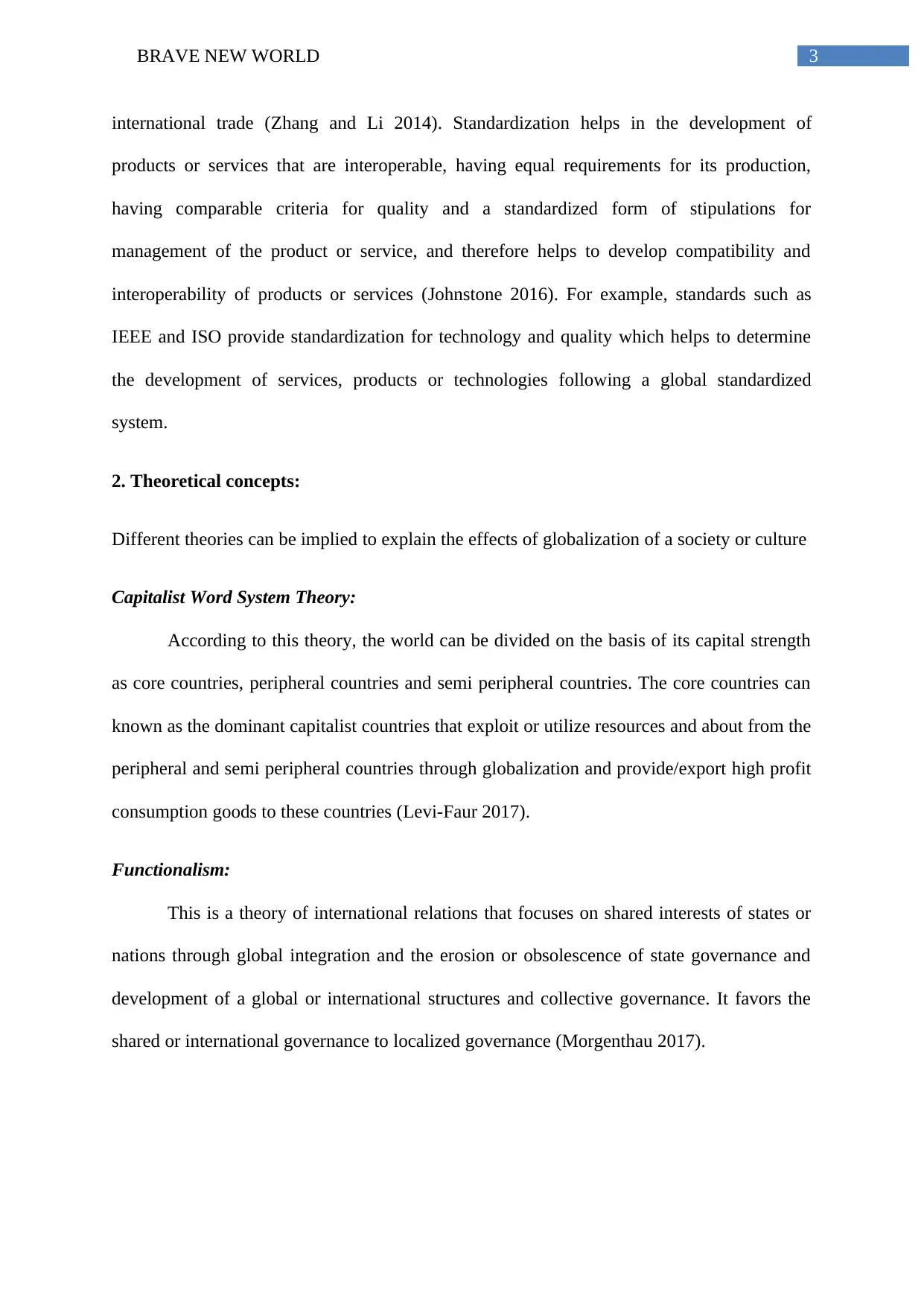
3BRAVE NEW WORLD
international trade (Zhang and Li 2014). Standardization helps in the development of
products or services that are interoperable, having equal requirements for its production,
having comparable criteria for quality and a standardized form of stipulations for
management of the product or service, and therefore helps to develop compatibility and
interoperability of products or services (Johnstone 2016). For example, standards such as
IEEE and ISO provide standardization for technology and quality which helps to determine
the development of services, products or technologies following a global standardized
system.
2. Theoretical concepts:
Different theories can be implied to explain the effects of globalization of a society or culture
Capitalist Word System Theory:
According to this theory, the world can be divided on the basis of its capital strength
as core countries, peripheral countries and semi peripheral countries. The core countries can
known as the dominant capitalist countries that exploit or utilize resources and about from the
peripheral and semi peripheral countries through globalization and provide/export high profit
consumption goods to these countries (Levi-Faur 2017).
Functionalism:
This is a theory of international relations that focuses on shared interests of states or
nations through global integration and the erosion or obsolescence of state governance and
development of a global or international structures and collective governance. It favors the
shared or international governance to localized governance (Morgenthau 2017).
international trade (Zhang and Li 2014). Standardization helps in the development of
products or services that are interoperable, having equal requirements for its production,
having comparable criteria for quality and a standardized form of stipulations for
management of the product or service, and therefore helps to develop compatibility and
interoperability of products or services (Johnstone 2016). For example, standards such as
IEEE and ISO provide standardization for technology and quality which helps to determine
the development of services, products or technologies following a global standardized
system.
2. Theoretical concepts:
Different theories can be implied to explain the effects of globalization of a society or culture
Capitalist Word System Theory:
According to this theory, the world can be divided on the basis of its capital strength
as core countries, peripheral countries and semi peripheral countries. The core countries can
known as the dominant capitalist countries that exploit or utilize resources and about from the
peripheral and semi peripheral countries through globalization and provide/export high profit
consumption goods to these countries (Levi-Faur 2017).
Functionalism:
This is a theory of international relations that focuses on shared interests of states or
nations through global integration and the erosion or obsolescence of state governance and
development of a global or international structures and collective governance. It favors the
shared or international governance to localized governance (Morgenthau 2017).
Paraphrase This Document
Need a fresh take? Get an instant paraphrase of this document with our AI Paraphraser
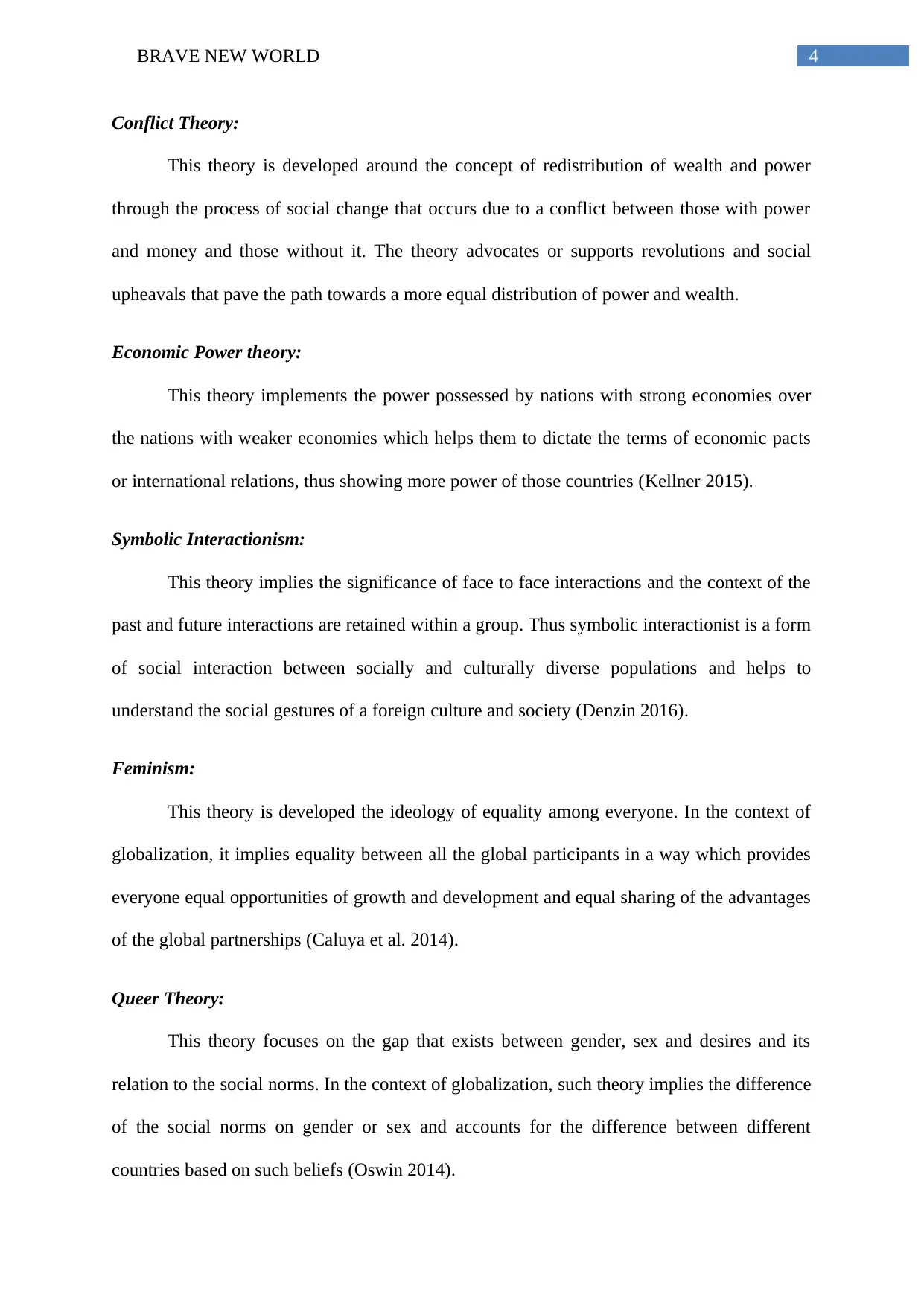
4BRAVE NEW WORLD
Conflict Theory:
This theory is developed around the concept of redistribution of wealth and power
through the process of social change that occurs due to a conflict between those with power
and money and those without it. The theory advocates or supports revolutions and social
upheavals that pave the path towards a more equal distribution of power and wealth.
Economic Power theory:
This theory implements the power possessed by nations with strong economies over
the nations with weaker economies which helps them to dictate the terms of economic pacts
or international relations, thus showing more power of those countries (Kellner 2015).
Symbolic Interactionism:
This theory implies the significance of face to face interactions and the context of the
past and future interactions are retained within a group. Thus symbolic interactionist is a form
of social interaction between socially and culturally diverse populations and helps to
understand the social gestures of a foreign culture and society (Denzin 2016).
Feminism:
This theory is developed the ideology of equality among everyone. In the context of
globalization, it implies equality between all the global participants in a way which provides
everyone equal opportunities of growth and development and equal sharing of the advantages
of the global partnerships (Caluya et al. 2014).
Queer Theory:
This theory focuses on the gap that exists between gender, sex and desires and its
relation to the social norms. In the context of globalization, such theory implies the difference
of the social norms on gender or sex and accounts for the difference between different
countries based on such beliefs (Oswin 2014).
Conflict Theory:
This theory is developed around the concept of redistribution of wealth and power
through the process of social change that occurs due to a conflict between those with power
and money and those without it. The theory advocates or supports revolutions and social
upheavals that pave the path towards a more equal distribution of power and wealth.
Economic Power theory:
This theory implements the power possessed by nations with strong economies over
the nations with weaker economies which helps them to dictate the terms of economic pacts
or international relations, thus showing more power of those countries (Kellner 2015).
Symbolic Interactionism:
This theory implies the significance of face to face interactions and the context of the
past and future interactions are retained within a group. Thus symbolic interactionist is a form
of social interaction between socially and culturally diverse populations and helps to
understand the social gestures of a foreign culture and society (Denzin 2016).
Feminism:
This theory is developed the ideology of equality among everyone. In the context of
globalization, it implies equality between all the global participants in a way which provides
everyone equal opportunities of growth and development and equal sharing of the advantages
of the global partnerships (Caluya et al. 2014).
Queer Theory:
This theory focuses on the gap that exists between gender, sex and desires and its
relation to the social norms. In the context of globalization, such theory implies the difference
of the social norms on gender or sex and accounts for the difference between different
countries based on such beliefs (Oswin 2014).
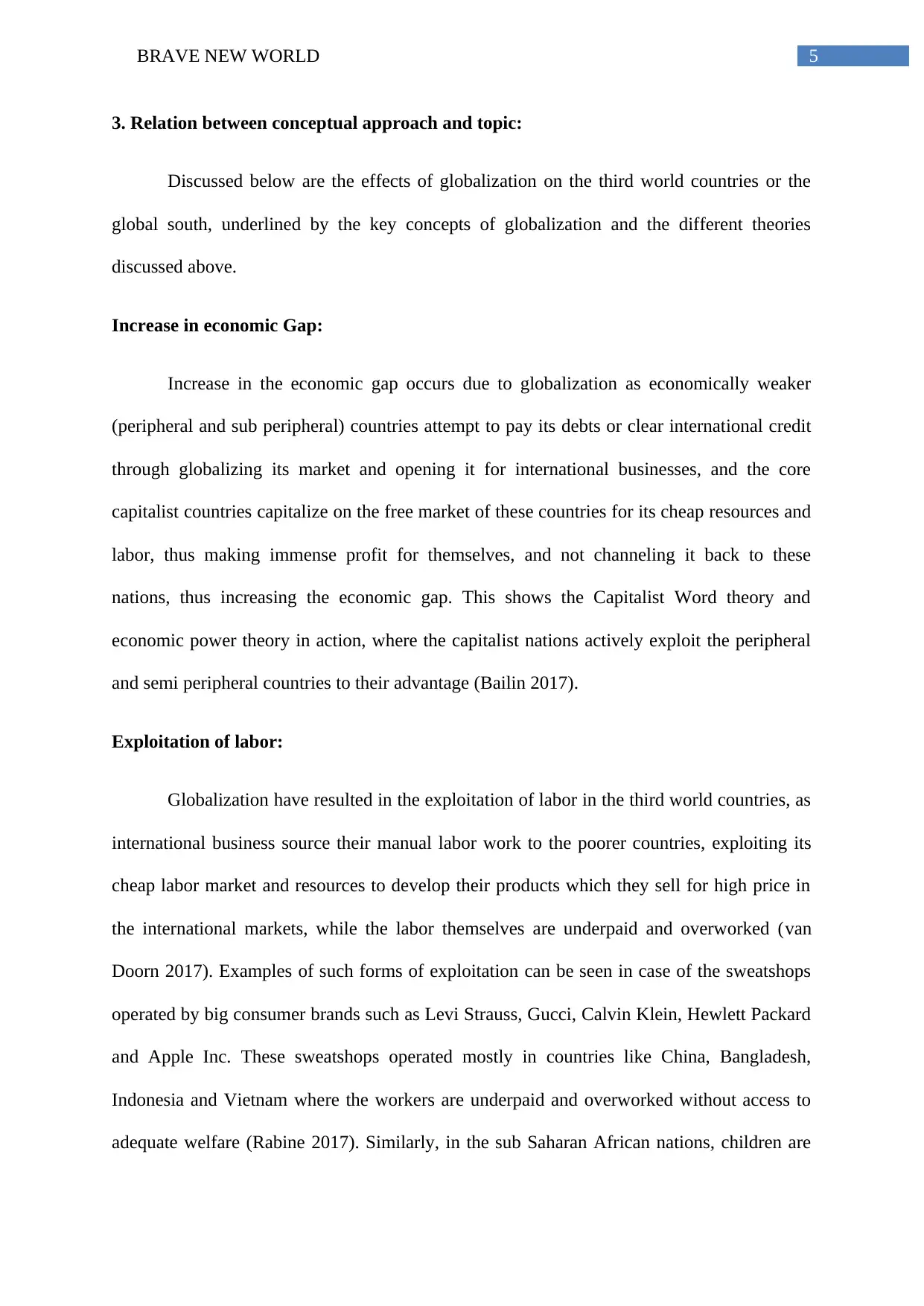
5BRAVE NEW WORLD
3. Relation between conceptual approach and topic:
Discussed below are the effects of globalization on the third world countries or the
global south, underlined by the key concepts of globalization and the different theories
discussed above.
Increase in economic Gap:
Increase in the economic gap occurs due to globalization as economically weaker
(peripheral and sub peripheral) countries attempt to pay its debts or clear international credit
through globalizing its market and opening it for international businesses, and the core
capitalist countries capitalize on the free market of these countries for its cheap resources and
labor, thus making immense profit for themselves, and not channeling it back to these
nations, thus increasing the economic gap. This shows the Capitalist Word theory and
economic power theory in action, where the capitalist nations actively exploit the peripheral
and semi peripheral countries to their advantage (Bailin 2017).
Exploitation of labor:
Globalization have resulted in the exploitation of labor in the third world countries, as
international business source their manual labor work to the poorer countries, exploiting its
cheap labor market and resources to develop their products which they sell for high price in
the international markets, while the labor themselves are underpaid and overworked (van
Doorn 2017). Examples of such forms of exploitation can be seen in case of the sweatshops
operated by big consumer brands such as Levi Strauss, Gucci, Calvin Klein, Hewlett Packard
and Apple Inc. These sweatshops operated mostly in countries like China, Bangladesh,
Indonesia and Vietnam where the workers are underpaid and overworked without access to
adequate welfare (Rabine 2017). Similarly, in the sub Saharan African nations, children are
3. Relation between conceptual approach and topic:
Discussed below are the effects of globalization on the third world countries or the
global south, underlined by the key concepts of globalization and the different theories
discussed above.
Increase in economic Gap:
Increase in the economic gap occurs due to globalization as economically weaker
(peripheral and sub peripheral) countries attempt to pay its debts or clear international credit
through globalizing its market and opening it for international businesses, and the core
capitalist countries capitalize on the free market of these countries for its cheap resources and
labor, thus making immense profit for themselves, and not channeling it back to these
nations, thus increasing the economic gap. This shows the Capitalist Word theory and
economic power theory in action, where the capitalist nations actively exploit the peripheral
and semi peripheral countries to their advantage (Bailin 2017).
Exploitation of labor:
Globalization have resulted in the exploitation of labor in the third world countries, as
international business source their manual labor work to the poorer countries, exploiting its
cheap labor market and resources to develop their products which they sell for high price in
the international markets, while the labor themselves are underpaid and overworked (van
Doorn 2017). Examples of such forms of exploitation can be seen in case of the sweatshops
operated by big consumer brands such as Levi Strauss, Gucci, Calvin Klein, Hewlett Packard
and Apple Inc. These sweatshops operated mostly in countries like China, Bangladesh,
Indonesia and Vietnam where the workers are underpaid and overworked without access to
adequate welfare (Rabine 2017). Similarly, in the sub Saharan African nations, children are
⊘ This is a preview!⊘
Do you want full access?
Subscribe today to unlock all pages.

Trusted by 1+ million students worldwide
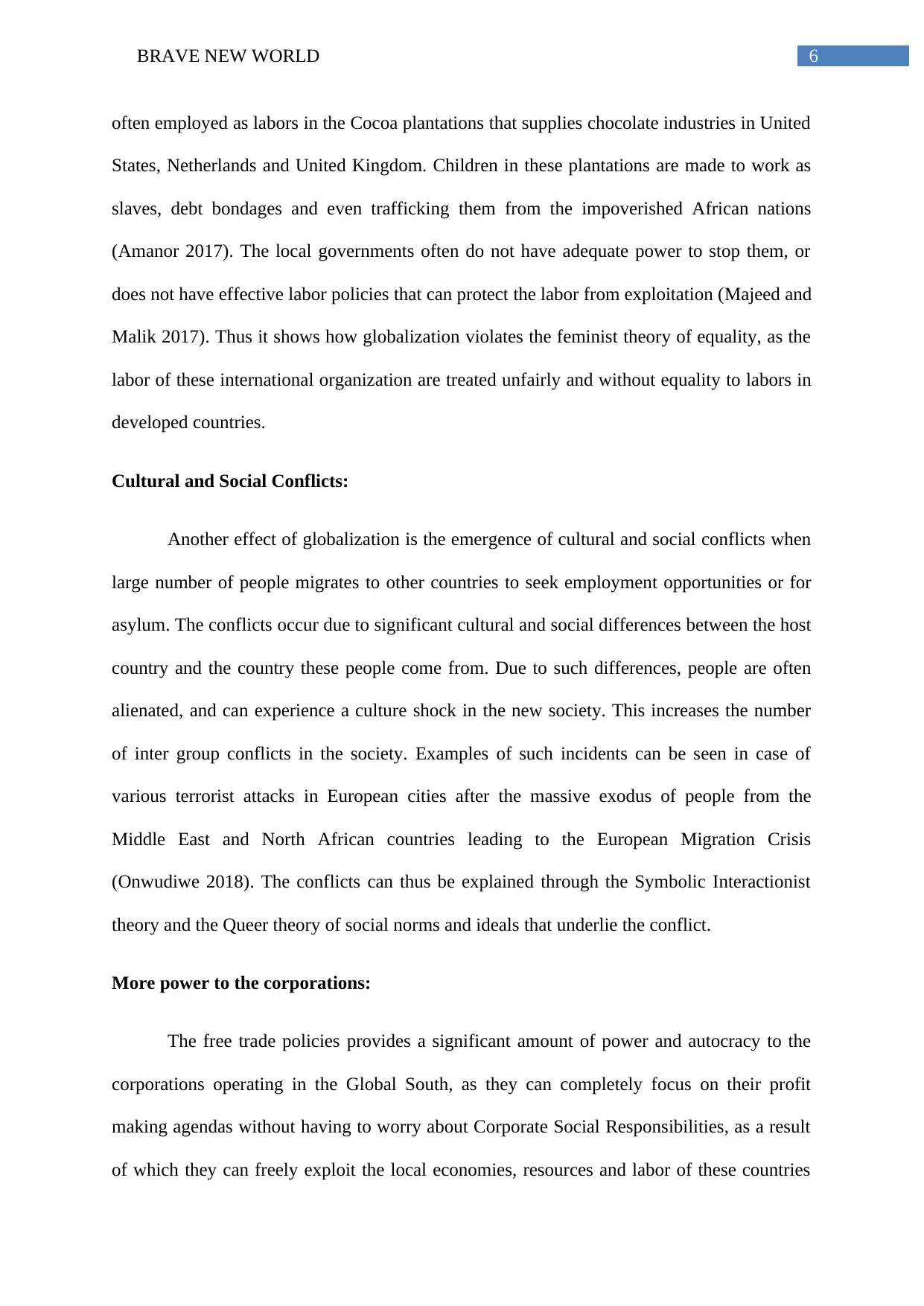
6BRAVE NEW WORLD
often employed as labors in the Cocoa plantations that supplies chocolate industries in United
States, Netherlands and United Kingdom. Children in these plantations are made to work as
slaves, debt bondages and even trafficking them from the impoverished African nations
(Amanor 2017). The local governments often do not have adequate power to stop them, or
does not have effective labor policies that can protect the labor from exploitation (Majeed and
Malik 2017). Thus it shows how globalization violates the feminist theory of equality, as the
labor of these international organization are treated unfairly and without equality to labors in
developed countries.
Cultural and Social Conflicts:
Another effect of globalization is the emergence of cultural and social conflicts when
large number of people migrates to other countries to seek employment opportunities or for
asylum. The conflicts occur due to significant cultural and social differences between the host
country and the country these people come from. Due to such differences, people are often
alienated, and can experience a culture shock in the new society. This increases the number
of inter group conflicts in the society. Examples of such incidents can be seen in case of
various terrorist attacks in European cities after the massive exodus of people from the
Middle East and North African countries leading to the European Migration Crisis
(Onwudiwe 2018). The conflicts can thus be explained through the Symbolic Interactionist
theory and the Queer theory of social norms and ideals that underlie the conflict.
More power to the corporations:
The free trade policies provides a significant amount of power and autocracy to the
corporations operating in the Global South, as they can completely focus on their profit
making agendas without having to worry about Corporate Social Responsibilities, as a result
of which they can freely exploit the local economies, resources and labor of these countries
often employed as labors in the Cocoa plantations that supplies chocolate industries in United
States, Netherlands and United Kingdom. Children in these plantations are made to work as
slaves, debt bondages and even trafficking them from the impoverished African nations
(Amanor 2017). The local governments often do not have adequate power to stop them, or
does not have effective labor policies that can protect the labor from exploitation (Majeed and
Malik 2017). Thus it shows how globalization violates the feminist theory of equality, as the
labor of these international organization are treated unfairly and without equality to labors in
developed countries.
Cultural and Social Conflicts:
Another effect of globalization is the emergence of cultural and social conflicts when
large number of people migrates to other countries to seek employment opportunities or for
asylum. The conflicts occur due to significant cultural and social differences between the host
country and the country these people come from. Due to such differences, people are often
alienated, and can experience a culture shock in the new society. This increases the number
of inter group conflicts in the society. Examples of such incidents can be seen in case of
various terrorist attacks in European cities after the massive exodus of people from the
Middle East and North African countries leading to the European Migration Crisis
(Onwudiwe 2018). The conflicts can thus be explained through the Symbolic Interactionist
theory and the Queer theory of social norms and ideals that underlie the conflict.
More power to the corporations:
The free trade policies provides a significant amount of power and autocracy to the
corporations operating in the Global South, as they can completely focus on their profit
making agendas without having to worry about Corporate Social Responsibilities, as a result
of which they can freely exploit the local economies, resources and labor of these countries
Paraphrase This Document
Need a fresh take? Get an instant paraphrase of this document with our AI Paraphraser
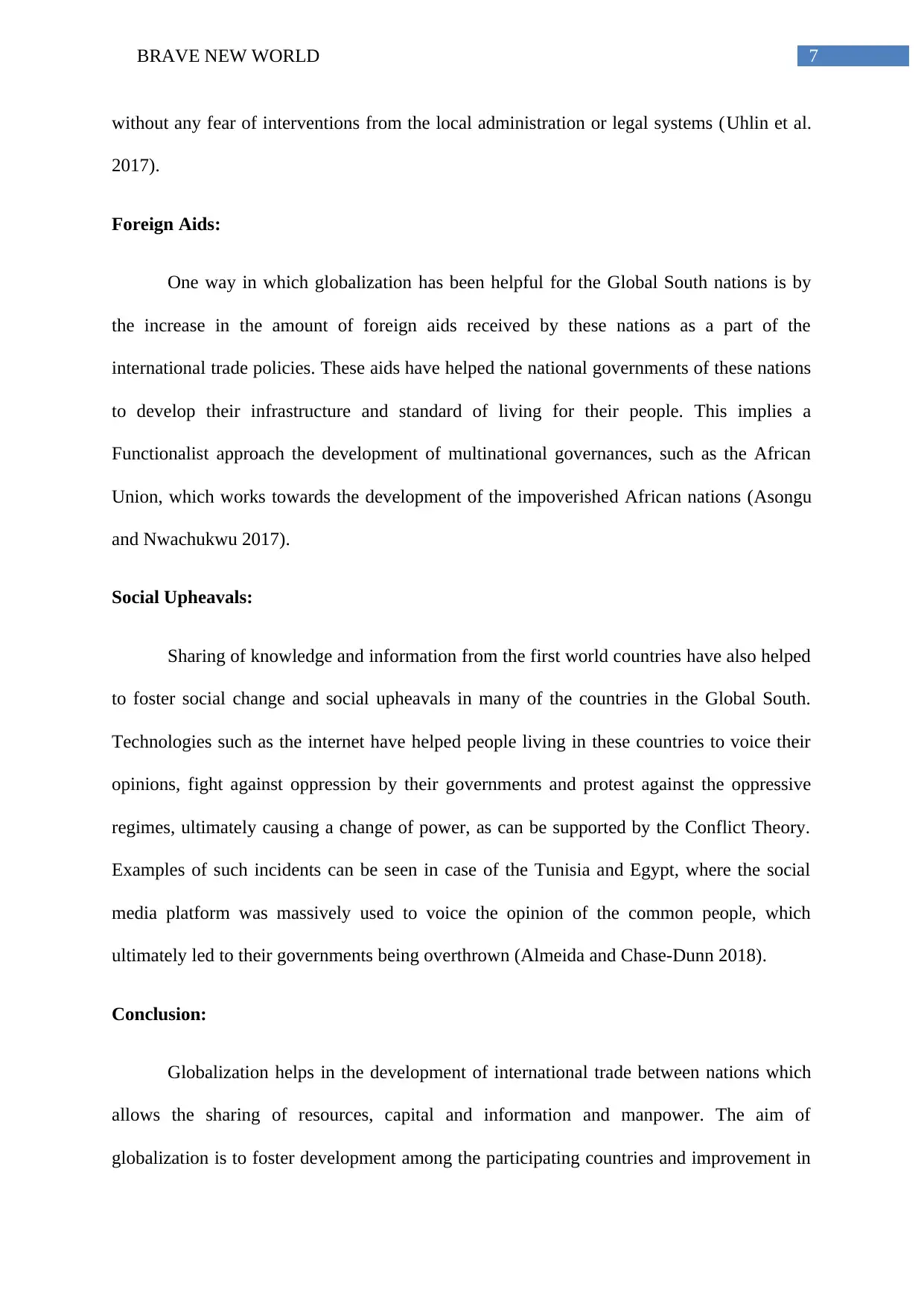
7BRAVE NEW WORLD
without any fear of interventions from the local administration or legal systems (Uhlin et al.
2017).
Foreign Aids:
One way in which globalization has been helpful for the Global South nations is by
the increase in the amount of foreign aids received by these nations as a part of the
international trade policies. These aids have helped the national governments of these nations
to develop their infrastructure and standard of living for their people. This implies a
Functionalist approach the development of multinational governances, such as the African
Union, which works towards the development of the impoverished African nations (Asongu
and Nwachukwu 2017).
Social Upheavals:
Sharing of knowledge and information from the first world countries have also helped
to foster social change and social upheavals in many of the countries in the Global South.
Technologies such as the internet have helped people living in these countries to voice their
opinions, fight against oppression by their governments and protest against the oppressive
regimes, ultimately causing a change of power, as can be supported by the Conflict Theory.
Examples of such incidents can be seen in case of the Tunisia and Egypt, where the social
media platform was massively used to voice the opinion of the common people, which
ultimately led to their governments being overthrown (Almeida and Chase-Dunn 2018).
Conclusion:
Globalization helps in the development of international trade between nations which
allows the sharing of resources, capital and information and manpower. The aim of
globalization is to foster development among the participating countries and improvement in
without any fear of interventions from the local administration or legal systems (Uhlin et al.
2017).
Foreign Aids:
One way in which globalization has been helpful for the Global South nations is by
the increase in the amount of foreign aids received by these nations as a part of the
international trade policies. These aids have helped the national governments of these nations
to develop their infrastructure and standard of living for their people. This implies a
Functionalist approach the development of multinational governances, such as the African
Union, which works towards the development of the impoverished African nations (Asongu
and Nwachukwu 2017).
Social Upheavals:
Sharing of knowledge and information from the first world countries have also helped
to foster social change and social upheavals in many of the countries in the Global South.
Technologies such as the internet have helped people living in these countries to voice their
opinions, fight against oppression by their governments and protest against the oppressive
regimes, ultimately causing a change of power, as can be supported by the Conflict Theory.
Examples of such incidents can be seen in case of the Tunisia and Egypt, where the social
media platform was massively used to voice the opinion of the common people, which
ultimately led to their governments being overthrown (Almeida and Chase-Dunn 2018).
Conclusion:
Globalization helps in the development of international trade between nations which
allows the sharing of resources, capital and information and manpower. The aim of
globalization is to foster development among the participating countries and improvement in
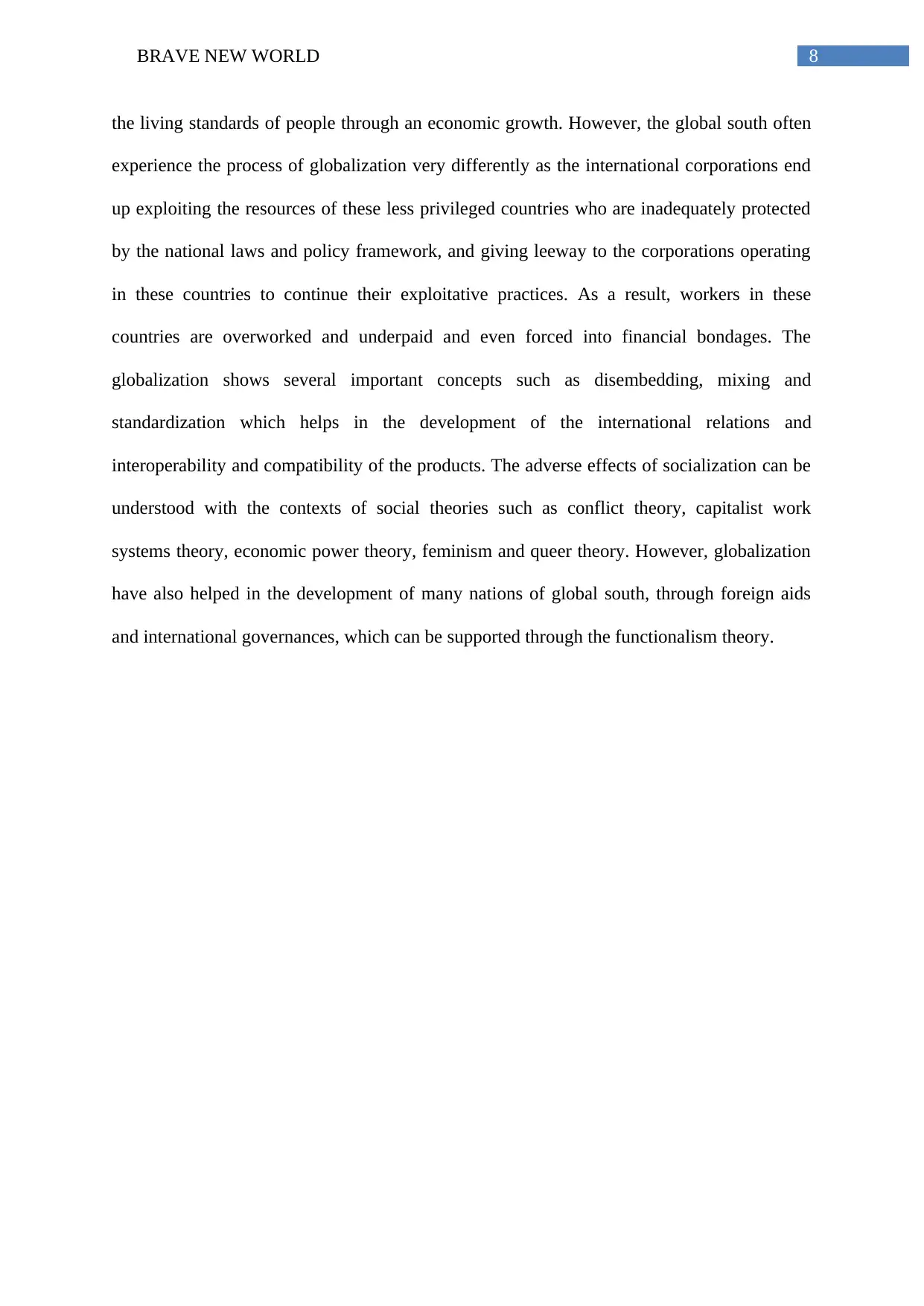
8BRAVE NEW WORLD
the living standards of people through an economic growth. However, the global south often
experience the process of globalization very differently as the international corporations end
up exploiting the resources of these less privileged countries who are inadequately protected
by the national laws and policy framework, and giving leeway to the corporations operating
in these countries to continue their exploitative practices. As a result, workers in these
countries are overworked and underpaid and even forced into financial bondages. The
globalization shows several important concepts such as disembedding, mixing and
standardization which helps in the development of the international relations and
interoperability and compatibility of the products. The adverse effects of socialization can be
understood with the contexts of social theories such as conflict theory, capitalist work
systems theory, economic power theory, feminism and queer theory. However, globalization
have also helped in the development of many nations of global south, through foreign aids
and international governances, which can be supported through the functionalism theory.
the living standards of people through an economic growth. However, the global south often
experience the process of globalization very differently as the international corporations end
up exploiting the resources of these less privileged countries who are inadequately protected
by the national laws and policy framework, and giving leeway to the corporations operating
in these countries to continue their exploitative practices. As a result, workers in these
countries are overworked and underpaid and even forced into financial bondages. The
globalization shows several important concepts such as disembedding, mixing and
standardization which helps in the development of the international relations and
interoperability and compatibility of the products. The adverse effects of socialization can be
understood with the contexts of social theories such as conflict theory, capitalist work
systems theory, economic power theory, feminism and queer theory. However, globalization
have also helped in the development of many nations of global south, through foreign aids
and international governances, which can be supported through the functionalism theory.
⊘ This is a preview!⊘
Do you want full access?
Subscribe today to unlock all pages.

Trusted by 1+ million students worldwide
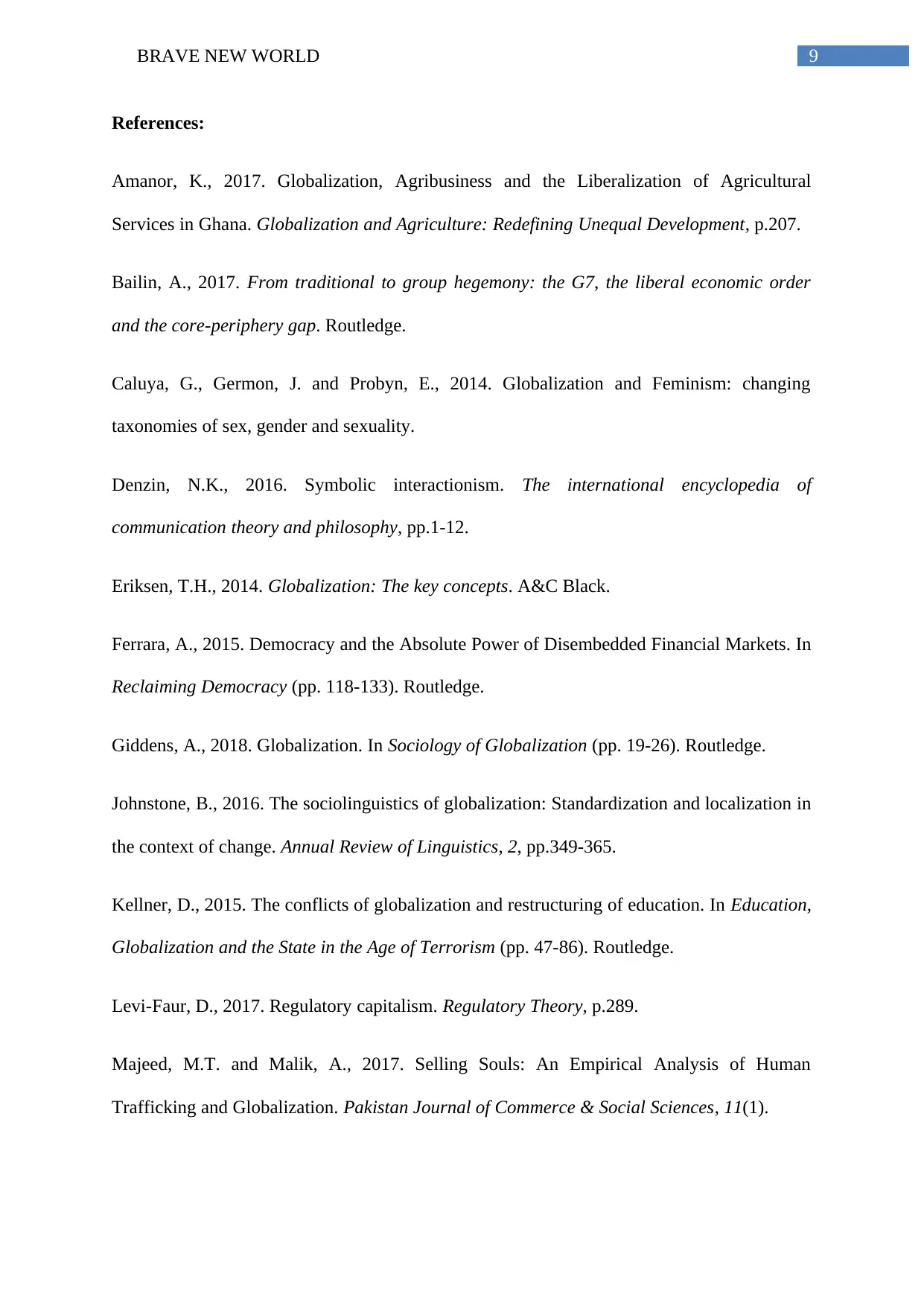
9BRAVE NEW WORLD
References:
Amanor, K., 2017. Globalization, Agribusiness and the Liberalization of Agricultural
Services in Ghana. Globalization and Agriculture: Redefining Unequal Development, p.207.
Bailin, A., 2017. From traditional to group hegemony: the G7, the liberal economic order
and the core-periphery gap. Routledge.
Caluya, G., Germon, J. and Probyn, E., 2014. Globalization and Feminism: changing
taxonomies of sex, gender and sexuality.
Denzin, N.K., 2016. Symbolic interactionism. The international encyclopedia of
communication theory and philosophy, pp.1-12.
Eriksen, T.H., 2014. Globalization: The key concepts. A&C Black.
Ferrara, A., 2015. Democracy and the Absolute Power of Disembedded Financial Markets. In
Reclaiming Democracy (pp. 118-133). Routledge.
Giddens, A., 2018. Globalization. In Sociology of Globalization (pp. 19-26). Routledge.
Johnstone, B., 2016. The sociolinguistics of globalization: Standardization and localization in
the context of change. Annual Review of Linguistics, 2, pp.349-365.
Kellner, D., 2015. The conflicts of globalization and restructuring of education. In Education,
Globalization and the State in the Age of Terrorism (pp. 47-86). Routledge.
Levi-Faur, D., 2017. Regulatory capitalism. Regulatory Theory, p.289.
Majeed, M.T. and Malik, A., 2017. Selling Souls: An Empirical Analysis of Human
Trafficking and Globalization. Pakistan Journal of Commerce & Social Sciences, 11(1).
References:
Amanor, K., 2017. Globalization, Agribusiness and the Liberalization of Agricultural
Services in Ghana. Globalization and Agriculture: Redefining Unequal Development, p.207.
Bailin, A., 2017. From traditional to group hegemony: the G7, the liberal economic order
and the core-periphery gap. Routledge.
Caluya, G., Germon, J. and Probyn, E., 2014. Globalization and Feminism: changing
taxonomies of sex, gender and sexuality.
Denzin, N.K., 2016. Symbolic interactionism. The international encyclopedia of
communication theory and philosophy, pp.1-12.
Eriksen, T.H., 2014. Globalization: The key concepts. A&C Black.
Ferrara, A., 2015. Democracy and the Absolute Power of Disembedded Financial Markets. In
Reclaiming Democracy (pp. 118-133). Routledge.
Giddens, A., 2018. Globalization. In Sociology of Globalization (pp. 19-26). Routledge.
Johnstone, B., 2016. The sociolinguistics of globalization: Standardization and localization in
the context of change. Annual Review of Linguistics, 2, pp.349-365.
Kellner, D., 2015. The conflicts of globalization and restructuring of education. In Education,
Globalization and the State in the Age of Terrorism (pp. 47-86). Routledge.
Levi-Faur, D., 2017. Regulatory capitalism. Regulatory Theory, p.289.
Majeed, M.T. and Malik, A., 2017. Selling Souls: An Empirical Analysis of Human
Trafficking and Globalization. Pakistan Journal of Commerce & Social Sciences, 11(1).
Paraphrase This Document
Need a fresh take? Get an instant paraphrase of this document with our AI Paraphraser
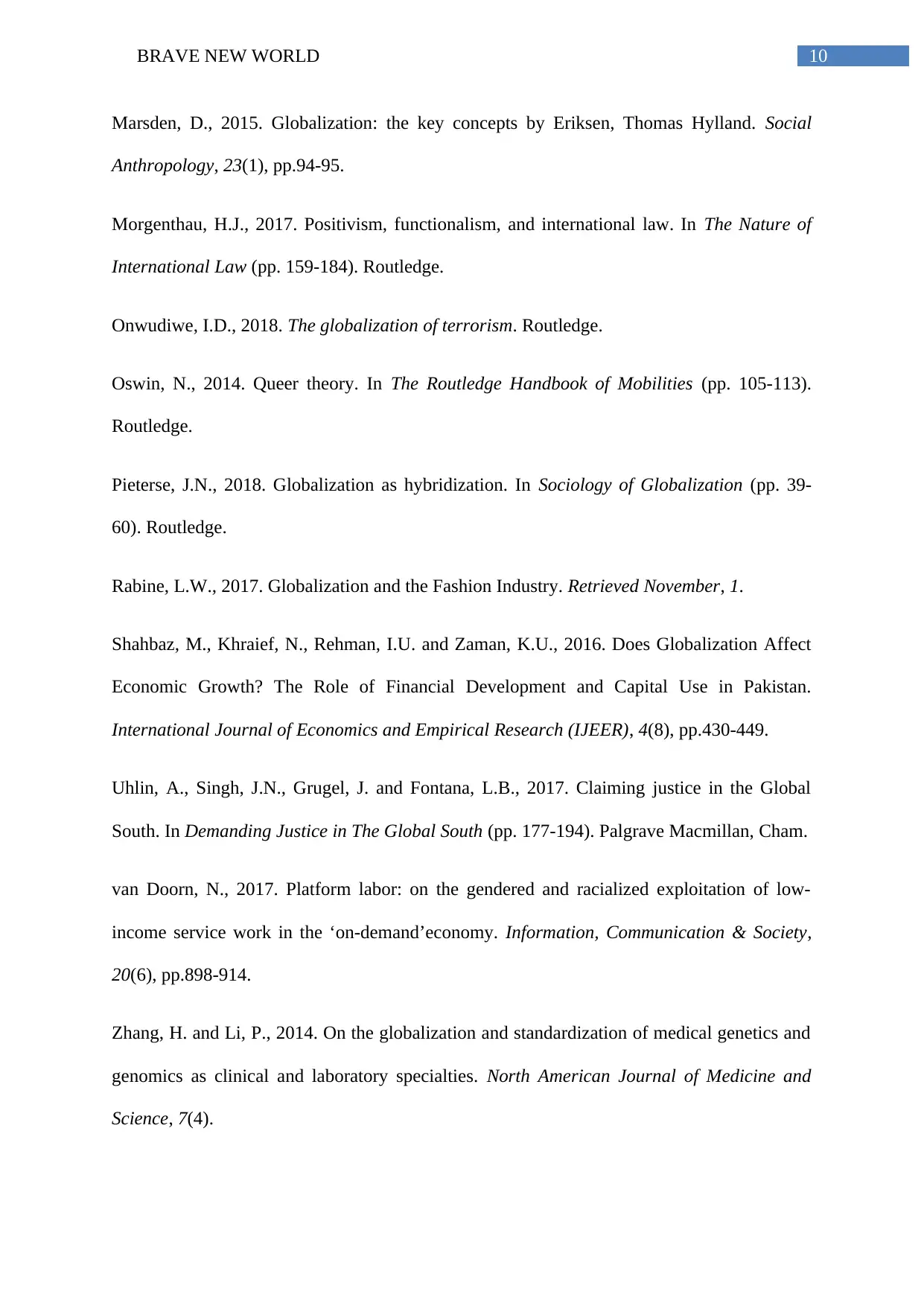
10BRAVE NEW WORLD
Marsden, D., 2015. Globalization: the key concepts by Eriksen, Thomas Hylland. Social
Anthropology, 23(1), pp.94-95.
Morgenthau, H.J., 2017. Positivism, functionalism, and international law. In The Nature of
International Law (pp. 159-184). Routledge.
Onwudiwe, I.D., 2018. The globalization of terrorism. Routledge.
Oswin, N., 2014. Queer theory. In The Routledge Handbook of Mobilities (pp. 105-113).
Routledge.
Pieterse, J.N., 2018. Globalization as hybridization. In Sociology of Globalization (pp. 39-
60). Routledge.
Rabine, L.W., 2017. Globalization and the Fashion Industry. Retrieved November, 1.
Shahbaz, M., Khraief, N., Rehman, I.U. and Zaman, K.U., 2016. Does Globalization Affect
Economic Growth? The Role of Financial Development and Capital Use in Pakistan.
International Journal of Economics and Empirical Research (IJEER), 4(8), pp.430-449.
Uhlin, A., Singh, J.N., Grugel, J. and Fontana, L.B., 2017. Claiming justice in the Global
South. In Demanding Justice in The Global South (pp. 177-194). Palgrave Macmillan, Cham.
van Doorn, N., 2017. Platform labor: on the gendered and racialized exploitation of low-
income service work in the ‘on-demand’economy. Information, Communication & Society,
20(6), pp.898-914.
Zhang, H. and Li, P., 2014. On the globalization and standardization of medical genetics and
genomics as clinical and laboratory specialties. North American Journal of Medicine and
Science, 7(4).
Marsden, D., 2015. Globalization: the key concepts by Eriksen, Thomas Hylland. Social
Anthropology, 23(1), pp.94-95.
Morgenthau, H.J., 2017. Positivism, functionalism, and international law. In The Nature of
International Law (pp. 159-184). Routledge.
Onwudiwe, I.D., 2018. The globalization of terrorism. Routledge.
Oswin, N., 2014. Queer theory. In The Routledge Handbook of Mobilities (pp. 105-113).
Routledge.
Pieterse, J.N., 2018. Globalization as hybridization. In Sociology of Globalization (pp. 39-
60). Routledge.
Rabine, L.W., 2017. Globalization and the Fashion Industry. Retrieved November, 1.
Shahbaz, M., Khraief, N., Rehman, I.U. and Zaman, K.U., 2016. Does Globalization Affect
Economic Growth? The Role of Financial Development and Capital Use in Pakistan.
International Journal of Economics and Empirical Research (IJEER), 4(8), pp.430-449.
Uhlin, A., Singh, J.N., Grugel, J. and Fontana, L.B., 2017. Claiming justice in the Global
South. In Demanding Justice in The Global South (pp. 177-194). Palgrave Macmillan, Cham.
van Doorn, N., 2017. Platform labor: on the gendered and racialized exploitation of low-
income service work in the ‘on-demand’economy. Information, Communication & Society,
20(6), pp.898-914.
Zhang, H. and Li, P., 2014. On the globalization and standardization of medical genetics and
genomics as clinical and laboratory specialties. North American Journal of Medicine and
Science, 7(4).

11BRAVE NEW WORLD
Zotzmann, K., 2016. Intercultural Competence: Value Disembedding and Hyper-flexibility.
In Intercultural Competence in Education (pp. 237-257). Palgrave Macmillan, London.
Zotzmann, K., 2016. Intercultural Competence: Value Disembedding and Hyper-flexibility.
In Intercultural Competence in Education (pp. 237-257). Palgrave Macmillan, London.
⊘ This is a preview!⊘
Do you want full access?
Subscribe today to unlock all pages.

Trusted by 1+ million students worldwide
1 out of 12
Related Documents
Your All-in-One AI-Powered Toolkit for Academic Success.
+13062052269
info@desklib.com
Available 24*7 on WhatsApp / Email
![[object Object]](/_next/static/media/star-bottom.7253800d.svg)
Unlock your academic potential
Copyright © 2020–2025 A2Z Services. All Rights Reserved. Developed and managed by ZUCOL.





